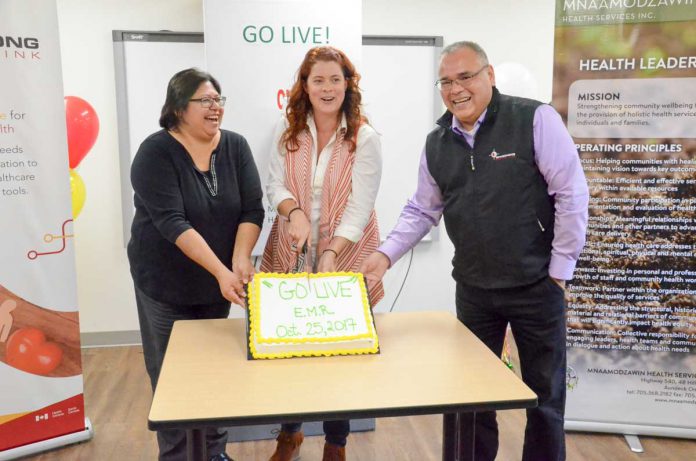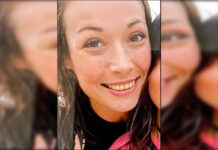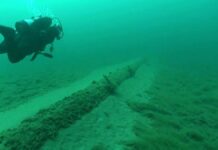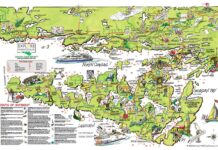
AUNDECK OMNI KANING—The excitement was electric in the meeting room at Mnaamodzawin Health Services as a symbolic switch was thrown to celebrate the Go Live launch of the community’s Giiwednong Health Link (GHL) electronic medical records system.
The Go Live launch began with a cleansing ceremony and drum song performed by Craig Abotossaway, who related the story of the Creator sending the slow and steady but powerful M’Kwa (the bear spirit) out across the land to ensure that everything was in place for the arrival of mankind. Although he took much longer to complete the task, M’Kwa succeeded where a host of other animals had failed.
Acting Mnaamodzawin Health Services Chair Kevin Mossip noted that the electronic medical records system provided by GHL will allow for “overall better service to (the) First Nations people we serve” and the hope that further electronic record integration with more First Nations partners will happen in the future.
Giiwednong Health Link Executive Director Michael McGregor opened the official Go Live ceremony. “I am very pleased to be here today to celebrate this very important milestone with you,” he said. “First, I wish to extend my congratulations to all the First Nations leaders, chiefs and health directors for having the vision way back, when electronic medical records (EMRs) in our communities was simply an idea. Also, for having the commitment and persistence to work together with GHL through the many challenges, to jump over and through the many hurdles and hoops, to get to the point where we find ourselves today, celebrating the implementation of EMR systems in Mnaamodzawin and the Mnaamodzawin First Nation communities. It’s certainly been a long time coming. Finally, it’s here.
“While I am a relative newcomer to GHL and the EMR initiative, I understand that many of you have been either directly or indirectly involved in the GHL project for a long time,” he continued. “It is this type of involvement, whether it be as decision maker/leader for your community, manager/planner in your health centre, or community member/supporter, that has made this day possible. The results of your patience and dedication are evidenced here today…miigwetch.”
Mr. McGregor went on to note that while EMRs have been successfully implemented in the Mnaamodzawin communities, “the real work for your respective heath care teams will begin. With your new EMR tools in place, your health care teams will be better able to track accurate, real time health information, a big first step towards more effectively serving your respective community’s health care needs.”
He noted that “this Go Live event marks a total of 10 First Nations Health Centres that now have EMRs in place. Prior to this consolidated EMR implementation with MHS and the MHS communities over the past seven months, GHL has completed EMR implementations in five other First Nation health centres. These have been completed in Wiikwemkoong, Serpent River, M’Chigeeng, Atikameksheng and Sagamok First Nations, which now brings the total EMR implementations to 10 First Nation Health Centres.”
Mr. McGregor went on to acknowledge the ongoing support from a couple of GHL’s key partners, notably: “the 14 First Nation communities on Manitoulin and the North Shore; Health Canada (who has provided funding to GHL to undertake this very important work); and Telus Health who has steadfastly worked alongside GHL to implement the Practice Solutions Suite (PS Suite EMR) in our communities.”
But the work has just begun, he said. “EMR integrations/data sharing with our partners such as the Family Health Teams; aboriginal health access centres, including Noojmowin Teg Health Centre (which is affiliated with the Manitoulin First Nations) and N’Mninoeyaa Community Health Access Centre (which is affiliated with Mamaweswen, The North Shore Tribal Council); Better Reporting, for both federal and provincial health/funding partners; and the communities’ own First Nation health care teams (will work) to generate and use accurate real-time health information to better serve our communities health care needs.”
Digital/e-health initiatives continue to grow, he noted. “Opportunities to better serve First Nation patients in our own First Nations communities abound through things like better electronic client engagement to enable things like online/self service appointment bookings and automated appointment reminders; improved client/patient immunization monitoring; healthcare, such via their personally owned devices; e-referrals, etc.”
But that “ultimately, we in the healthcare sector always need to remember to keep one eye on the end goal of doing what is required to improve the health and well-being of our community members.”
Cameron Bales, PS Suite Trainer with Telus Health, expressed how well the integration team had worked together to make the Go Live launch a seamless success and noted that the system has a great number of links already, including the Northeast Family Health Team. “We are all on the same page electronically,” he said. “Telus Health is committed to ongoing improvement.”
Following the presentation of gifts to members of the team, a luncheon feast concluded the ceremonies.





